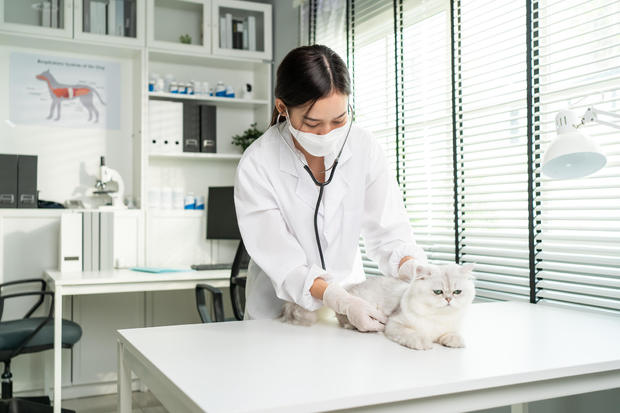Pet insurance and pre-existing conditions: What to know to save money
Pet insurance can help you offset expensive vet bills when your furry friend suffers an illness or injury. Depending on your policy options, your insurer may reimburse you up to 90% of your vet costs for eligible services and procedures.
Unfortunately, if your pet has a pre-existing condition, your pet insurance provider may not cover it. According to, it may be best to take out pet insurance while your pet is young to ensure they have coverage if they later develop any conditions that require treatment.
If you're considering pet insurance then reach out to a professional now who can help you get started with a free quote so you know exactly what to expect.
Before you start the process of getting pet insurance, it's essential to understand what's considered a pre-existing condition and how to save money on a policy.
Pet insurance and pre-existing conditions
As its name implies, a pre-existing condition is any illness or injury that precedes the start of your pet insurance policy. Pet insurance providers usually don't cover pre-existing conditions because of the high-risk they present. Many pre-existing conditions can be expensive and considering the short lifetime of pets compared to humans, there may not be enough time for pet insurers to collect the number of monthly premiums necessary to offset claim payments for pre-existing conditions.
When you file a claim, your insurer will request your pet's veterinary records to investigate the claim and determine if the condition existed before you signed up for pet insurance. Always be truthful and forthcoming when applying for a policy or filing a claim, as willfully misleading your insurer could be considered insurance fraud.
How pet owners can save money
If your pet has a pre-existing condition, it won't prevent you from getting pet insurance. You won't have coverage for the pre-existing issue, but you will have coverage for new, unconnected conditions that develop.
Even if your pet has a pre-existing condition, you still have a couple of options to help lower your animal care costs. Discounts are available for select seniors, veterans and other groups.
Another option is to turn to charitable organizations which may help you pay for health care for their pets. The Humane Society provides a comprehensive list of charitable organizations that provide financial assistance for pet owners, and some organizations are even breed-specific.
And don't hesitate to speak with a pet insurance professional who can help you build a cost-effective but reliable policy.
If your pet doesn't have a pre-existing condition, there should be few, if any, roadblocks to qualifying for coverage. Still, you'll want to work with an affordable pet insurance company that provides a wide array of services for their plans. Not all pet insurance providers are the same; some coverage options will be available with one provider but not another. Consequently, it's wise to shop and compare multiple policies to find the best value for pet insurance. Use the table below to get started.
If you're looking to lower your premiums, consider these options.
- Increase your deductible: Your deductible is a primary factor in your insurance premiums. Generally, the higher your deductible, the lower your premium will be since you're taking on more of the upfront cost of your pet care.
- Lower your reimbursement percentage: By lowering the reimbursement percentage you'll receive for your vet bill, you can reduce your monthly premium. Most policies give you the option to reimburse between 70% to 90% of your vet bill.
- Select a lower benefit amount: You can also reduce your monthly premium by adjusting your coverage. In reviewing Spot insurance, we could lower the rate on a sample policy from $92.21 per month to $45.70 per month simply by switching from the unlimited coverage amount to $5,000 worth of annual coverage.
- Choose an accident-only plan: Accident-only policies typically provide the most affordable coverage. You can find accident-only coverage for as low as $15 per month for dogs and $7 for cats.
- Take advantage of discounts: Most pet insurance companies provide policy discounts ranging from lower rates for veterinarians and their employees to multi-pet discounts. For example, Spot offers a 10% discount on additional pets you add to your policy. Lemonade also offers a discount when you bundle your pet insurance with other Lemonade policies like homeowners or renters insurance.
- Speak with your vet: Your veterinarian is well-versed in the health of your pet - and similar breeds and types. They can help you build a tailored policy so that you pay for coverage you'll need and not for coverage you won't.
Curable vs. incurable pre-existing conditions
A curable condition is any symptom, condition or illness your pet has been successfully treated for and cured, and may ultimately become eligible for coverage. Ear infections, urinary tract infections and upper respiratory infections are examples of common curable conditions.
Conversely, incurable pre-existing conditions like arthritis, hip dysplasia and epilepsy can never be cured. Instead, pet owners and veterinarians aim to manage these conditions and make life as comfortable as possible for our furry family members.
While you can't get coverage for an incurable pre-existing condition, you may be able to insure a curable condition if you meet your insurance company's requirements. Most pet insurers require at least six months free of symptoms to classify a condition as cured. Lemonade considers a pre-existing condition that is symptom-free and goes without treatment for 12 months or more to be considered cured. That condition "may be considered for coverage in eligible states."
Don't forget
Even without a diagnosis of a specific condition, symptoms can be considered pre-existing if they are noted before enrolling in your pet insurance coverage policy and are incurable. Say, for example, your pet's veterinary records document symptoms of hip dysplasia, like a decreased range of motion or weakness in the hind legs from a time before you took out your insurance policy. If your dog is later formally diagnosed with hip dysplasia, your insurer may consider the documented symptoms a pre-existing condition and decline coverage. If the symptoms are for a curable condition, your policy will likely cover the treatment.
If your dog or cat is in good health with no symptoms of any ailments or conditions, consider getting pet insurance now while you have more options for coverage and you can get a good rate. If an unfortunate health condition surfaces in the future, you'll likely have coverage for treatment at your current rate.




